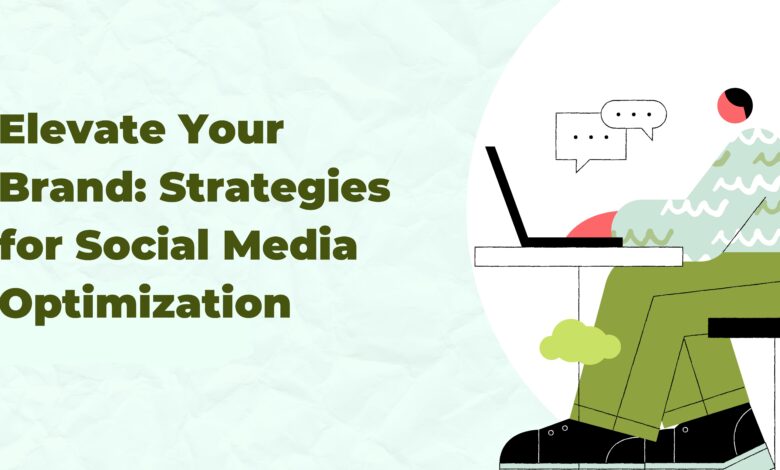Elevate Your Brand: Strategies for Social Media Optimization

Elevate Your Brand: Strategies for Social Media Optimization
In the digital age, social media has become a vital part of every successful brand’s marketing strategy. From small businesses to large enterprises, an effective social media presence can boost brand awareness, engage customers, and drive sales. Social media optimization (SMO) plays a key role in this process. SMO focuses on using social media networks to manage and grow an organization’s online presence and can be a powerful tool for increasing visibility and engagement.
In this article, we will explore various strategies to optimize your brand’s social media platforms, focusing on improving reach, engagement, and conversion rates. We’ll cover tactics such as content creation, audience engagement, platform-specific strategies, and best practices for ensuring your brand stands out in a crowded digital space.
Why Social Media Optimization (SMO) Matters
SMO goes beyond simply posting content on social media platforms. It involves strategic efforts to ensure that each post, interaction, and campaign aligns with a broader marketing goal. The importance of SMO lies in its ability to enhance brand visibility, drive traffic, and generate leads. Here’s why SMO is critical for any business today:
Increased Visibility and Reach
Social media platforms such as Facebook, Instagram, Twitter, LinkedIn, and TikTok provide businesses with the opportunity to reach millions of users worldwide. Through SMO, you can increase the chances of your content being discovered by potential customers by using relevant hashtags, optimizing post timings, and collaborating with influencers.
Boosting Engagement and Interaction
Optimizing your social media efforts ensures that you not only reach a larger audience but also keep them engaged. Engagement on social media involves comments, shares, likes, and conversations. SMO allows you to design your posts and strategies in a way that encourages interaction, fostering a stronger connection between your brand and its audience.
Better Conversion Rates
The ultimate goal of SMO is to turn social media followers into loyal customers. With strategic SMO efforts, you can guide potential customers through the funnel, from awareness to interest, and eventually, to conversion. Whether you’re looking to increase website traffic, boost sales, or improve lead generation, SMO can significantly improve your conversion rates.
Enhancing Your Brand’s Authority
When your brand consistently appears across social media platforms with valuable content and active engagement, it builds credibility and authority in your industry. SMO ensures that your brand’s message is clear and consistent, fostering trust and loyalty among your audience.
Key Components of Social Media Optimization
To elevate your brand through social media optimization, several components must be considered. Each of these aspects plays a critical role in ensuring that your efforts yield the best results.
Content Creation and Curation
The Importance of Quality Content
Content is king in the world of social media. Without engaging, informative, or entertaining content, it’s difficult to keep your audience’s attention. The key to successful SMO lies in creating content that resonates with your target audience while remaining aligned with your brand’s goals.
Types of Content
- Visual Content: Posts with images, infographics, and videos typically perform better than text-only posts. Visual content captures attention and is more likely to be shared.
- Interactive Content: Quizzes, polls, and challenges encourage users to engage with your brand directly.
- User-Generated Content: Sharing content created by your followers, such as testimonials or photos, builds trust and a sense of community.
Consistency is Key
Posting regularly is essential to maintaining visibility on social media. Create a content calendar to ensure that you’re consistently sharing valuable content with your audience. Consistent posting keeps your brand top of mind and shows your followers that your business is active and engaged.
Understanding Your Audience
A deep understanding of your audience is crucial for effective SMO. Knowing who your followers are, what they care about, and when they are most active online will help you tailor your content and engagement strategies.
Audience Research and Segmentation
By conducting audience research, you can gather insights about your followers’ demographics, preferences, and behaviors. This can be done through tools like Facebook Insights, Twitter Analytics, and third-party platforms like Google Analytics. Once you have this data, segment your audience into specific groups based on common traits such as age, interests, or location.
Creating Buyer Personas
A buyer persona is a semi-fictional representation of your ideal customer based on real data. Developing detailed personas helps you tailor your social media posts and campaigns to the needs, desires, and pain points of your audience, resulting in better engagement and higher conversion rates.
Platform-Specific Strategies
Each social media platform has its own unique features and audience. It’s essential to understand these differences and tailor your SMO efforts accordingly. Let’s take a look at how to optimize your presence on some of the most popular social platforms.
- Optimize Your Profile: Make sure your Facebook profile is complete with an up-to-date bio, profile picture, and cover image. Use keywords in your bio to help people find your page.
- Post at Optimal Times: Use Facebook Insights to discover when your audience is most active and schedule your posts accordingly.
- Engage with Your Audience: Respond to comments, messages, and reviews. Engaging with your audience helps build a community and enhances trust in your brand.
- Use Hashtags Strategically: Instagram allows up to 30 hashtags per post, but it’s important to use relevant and popular hashtags to increase visibility.
- Leverage Instagram Stories: Stories are a great way to engage your audience with behind-the-scenes content, polls, or time-sensitive offers.
- Focus on Aesthetics: Instagram is a highly visual platform, so ensure your posts are visually appealing and consistent with your brand’s aesthetic.
- Optimize Your Tweets: Keep your tweets short, concise, and to the point. Use relevant hashtags to increase discoverability.
- Engage in Conversations: Twitter is a great platform for joining industry conversations and trends. Engaging with trending topics and replying to your followers helps boost your visibility.
- Use Twitter Polls: Twitter Polls can increase engagement and provide valuable insights into your audience’s opinions.
- Optimize Your Company Page: Ensure your company’s LinkedIn page is complete with relevant keywords and descriptions. This helps potential clients or customers find you more easily.
- Share Industry Insights: LinkedIn is a platform for professionals, so sharing insights, articles, and industry-related news can position your brand as an authority in your niche.
- Leverage LinkedIn Groups: Joining and engaging in LinkedIn Groups related to your industry can help you connect with potential customers and expand your network.
Best Practices for Social Media Optimization
Now that we’ve covered platform-specific strategies, let’s delve into some general best practices that will improve your SMO efforts across the board.
Use Analytics to Track Performance
One of the advantages of social media is the ability to track your performance using analytics tools. By regularly monitoring key metrics such as engagement rates, follower growth, and website traffic, you can identify what’s working and what needs improvement. Many platforms, such as Facebook, Twitter, and Instagram, offer built-in analytics, while third-party tools like Hootsuite and Sprout Social provide more detailed insights.
Engage With Your Audience
Effective SMO is not just about posting content but also about fostering a community. Respond to comments, questions, and messages in a timely manner. The more you interact with your audience, the more likely they are to engage with your brand and share your content with others.
Optimize Your Profiles
Your social media profiles are often the first point of contact between your brand and potential customers. Make sure your profiles are fully optimized with complete information, including a clear bio, profile picture, and contact details. Also, include links to your website, and ensure that your branding is consistent across all platforms.
Use Hashtags Wisely
Hashtags help people discover your content on platforms like Instagram and Twitter. However, it’s important to use them strategically. Avoid using too many hashtags or irrelevant ones, as this can make your posts look spammy. Instead, research popular and relevant hashtags in your industry to maximize your reach.
Leverage Influencers
Partnering with influencers can significantly boost your brand’s visibility. Influencers have a dedicated following, and their endorsement of your product or service can lead to increased trust and credibility. When choosing influencers to work with, make sure their audience aligns with your target demographic.
Create Shareable Content
The more shareable your content is, the greater your chances of reaching a wider audience. Content that evokes emotion, educates, or entertains tends to be shared more frequently. Consider incorporating infographics, humorous content, or inspiring stories that your audience would feel compelled to share with their network.
Regularly Update Your Strategy
Social media trends change rapidly, so it’s essential to stay updated with the latest developments. Regularly review your SMO strategy and adjust it to reflect new trends, algorithms, or platform features. This will keep your brand relevant and ensure that your social media efforts are always aligned with your broader marketing goals.
Conclusion
Social media optimization is a powerful tool for elevating your brand and ensuring your business thrives in the competitive digital landscape. By focusing on creating high-quality content, understanding your audience, implementing platform-specific strategies, and following best practices, you can significantly increase your brand’s visibility and engagement. Consistency, engagement, and analysis are key to ongoing success in social media optimization.
Incorporating SMO strategies into your digital marketing plan will help you build a loyal customer base and drive conversions. For businesses looking to take their social media presence to the next level, partnering with an SMO agency can provide expert guidance and execution, ensuring that your efforts yield the best possible results.
FAQs:
1. What is Social Media Optimization (SMO) and why is it important for my business?
Social Media Optimization (SMO) refers to the process of enhancing a brand’s social media presence to increase visibility, engagement, and conversions. It involves creating compelling content, optimizing profiles, using relevant hashtags, and engaging with the audience. SMO is crucial for your business because it helps you reach a wider audience, boost brand awareness, and foster customer loyalty, all of which can lead to increased traffic, leads, and sales.
2. How can I effectively engage my audience on social media?
To effectively engage your audience, focus on posting valuable and relevant content consistently. Respond to comments, questions, and messages in a timely manner, and encourage interaction through polls, quizzes, and user-generated content. Understanding your audience’s preferences and behaviors is also essential. When you know what resonates with your followers, you can create posts that spark conversation and encourage shares, likes, and comments.
3. How do I measure the success of my social media optimization efforts?
You can measure the success of your SMO efforts by tracking key performance metrics such as engagement rates, follower growth, website traffic from social media, and conversion rates. Most social media platforms offer built-in analytics tools, like Facebook Insights and Twitter Analytics, which provide detailed data on how your posts are performing. Additionally, third-party tools like Hootsuite or Sprout Social can offer even more comprehensive analysis to help you refine your strategy over time.




